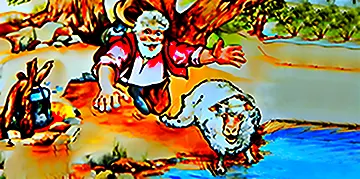Waltzing Matilda Song
Waltzing Matilda is an Australian folk song about a farm worker who camps by a small pond, where he steals a sheep and cooks it over a makeshift campfire. When the sheep's owner arrives with three policemen to arrest him, rather than face arrest, the swagman jumps into the pond and drowns.
The original lyrics of "Waltzing Matilda" were written by Banjo Paterson to capture the hardships faced by Australian itinerant workers in the 1800s and the rebellious spirit of these people. In 1903, Maria Cowan rearranged the song, and it quickly gained immense popularity. Today, "Waltzing Matilda" symbolises Australian identity, resilience, and the fight for social justice. It is often considered Australia's unofficial national anthem.
Waltzing Matilda Words Waltzing Matilda Lyrics
Once a jolly swagman camped by a billabong,
Under the shade of a coolibah tree,
And he sang as he watched and waited 'til his billy boiled,
Who'll come a-waltzing, Matilda, with me?
Waltzing Matilda, Waltzing Matilda,
Who'll come a-waltzing, Matilda, with me?
And he sang as he watched and waited 'til his billy boiled,
Who'll come a-waltzing, Matilda, with me?
Along came a jumbuck to drink at the billabong,
Up jumped the swagman and grabbed him with glee,
And he sang as he stowed that jumbuck in his tucker bag,
You'll come a-waltzing, Matilda, with me.
Waltzing Matilda, Waltzing Matilda,
Who'll come a-waltzing, Matilda, with me?
And he sang as he watched and waited 'til his billy boiled,
Who'll come a-waltzing, Matilda, with me?
Up rode the squatter, mounted on his thoroughbred,
Down came the troopers, one, two, three,
Whose is that jumbuck you've got in your tucker bag?
You'll come a-waltzing, Matilda, with me.
Waltzing Matilda, Waltzing Matilda,
Who'll come a-waltzing, Matilda, with me?
And he sang as he watched and waited 'til his billy boiled,
Who'll come a-waltzing, Matilda, with me?
Up jumped the swagman, leapt into the billabong,
You'll never catch me alive, said he,
And his ghost may be heard as you pass by the billabong,
Who'll come a-waltzing, Matilda, with me.
Waltzing Matilda, Waltzing Matilda,
Who'll come a-waltzing, Matilda, with me?
And he sang as he watched and waited 'til his billy boiled,
Who'll come a-waltzing, Matilda, with me?
Waltzing Matilda Meaning What Does Waltzing Matilda Mean
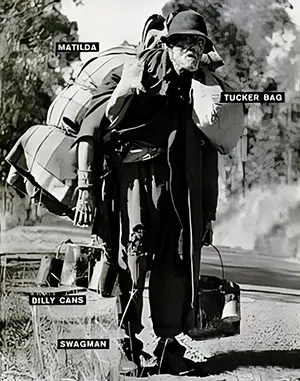
Photo: Swagman with a Matilda, Tucker Bag and Billy
The term "Waltzing Matilda" means to travel on foot, from place to place, carrying one's belongings in a bundle slung over one's back (see photo). This phrase gained popularity in the 1890s among impoverished workers in rural Australia. It originated from German immigrants who started settling in Australia around 1838. Waltzing is from the German term 'auf der walz', which means travelling while learning a trade. In Australia, the German word 'walz' became 'waltz' after a fashionable dance at the time. Matilda has German origins, too. It was a name given to females who accompanied soldiers during the Thirty Year Wars in Europe. The expression then evolved to mean" to be kept warm at night" and later to mean the great army coats or blankets that soldiers wrapped themselves with. These were rolled into a swag and carried behind their shoulders while marching. So that's how the phrase 'Waltzing Matilda' originated.
What is Waltzing Matilda About? Waltzing Matilda Lyrics Explained
Verses 1 & 2
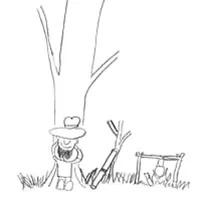
A hungry itinerant worker (swagman) is resting under a shady eucalyptus tree (coolibah) by the banks of a watering-hole (billabong). He has lit a fire and is making himself some tea in a tin can (billy) that he is using as a kettle. While waiting for his tea to boil, he is singing a phrase that asks, "Who will keep me company—who will be my friend, as I walk from place to place?
Verses 3 & 4
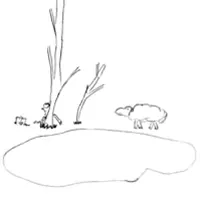
While resting by the billabong, singing his little tune, the swagman notices a sheep (jumbuck) wandering down to the watering-hole for a drink. The swagman is starving. He hasn't eaten in days. So he catches the sheep, kills it, eats what he can, and stows the rest in his backpack (tucker bag).
Verses 4 & 5
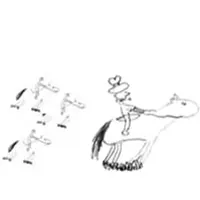
Unfortunately for the swagman, the wealthy landowner (squatter) arrives at the water-hole. He is riding his expensive horse (thoroughbred) and accompanied by three policemen (troopers). They catch the swagman red-handed with the remains of the sheep in his backpack and try to arrest him for killing the sheep.
Verses 6 & 7
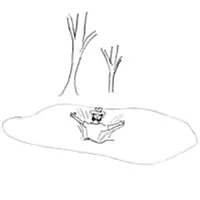
Preferring death over imprisonment for his crime, the swagman jumps into a water-hole and tries to escape. But, regrettably, the swagman drowns instead. Ever since that day, his ghost still haunts the water-hole and can be heard singing. "Who'll come a-waltzing, Matilda, with me?".
Explanation of Waltzing Matilda Words Words Used In Waltzing Matilda
Waltzing Matilda is composed of 32 lines in 8 verses. It uses an ABCB rhyming scheme with a ‘back and forth’ dialogue and a refrain to generate a melody that helps us remember the words of the song easily. The song uses many uniquely Australian words referred to as Strine. They are explained below.
Jolly – means happy (Not in common usage today).
Swagman – a hobo, an itinerant worker, who travelled from place to place in search of work. A swagman was usually extremely poor and carried all his belongings wrapped up in a blanket slung over his shoulder called a swag.
Billabong – a waterhole or pond. It is an aboriginal word meaning little or no water.
Coolibah Tree – a eucalyptus tree that usually grows near water. Derived from the aboriginal word gulabaa.
Billy – a tin can with a wire handle used to boil water.
Jumbuck – a sheep. It is derived from the two words jumping buck.
Waltz – means to travel from place to place. It originated from the German phrase "Auf der Walz" (roughly translated as "on the road").
Matilda –to carry one's belongings in a blanket slung over his shoulder.
Waltzing Matilda – see the detailed explanation below.
Tucker Bag – a bag for storing food (tucker). It was usually an old sugar or flour sack.
Squatter – a wealthy landowner, a rancher.
Thoroughbred – An expensive pedigreed horse. The Mercedes Benz equivalent of its day.
Trooper – a policeman, a mounted militia-man.
When Was Waltzing Matilda Written?Waltzing Matilda is Based on a True Story
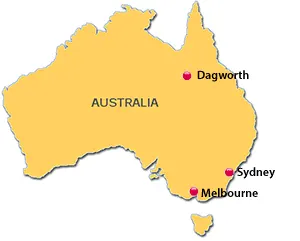
Photo: Map of sites from Waltzing Matilda
Waltzing Matilda is based on a true story and was written in 1895 by Banjo Paterson while visiting Dagworth Station in Outback Queensland. Dagworth Station was a huge cattle and sheep ranch owned by Bob Macpherson. While riding in a coach to Dagworth, they saw a swagman walking along the dusty road. Bob Macpherson turned to Banjo and said: "That's what they call "Waltzing the Matilda".
During his stay at Dagworth, Bob Macpherson and Banjo frequently went for long rides around the property. One day they stopped at a billabong, called the Combo Waterhole, where they found the remains of a recently slaughtered sheep. At this time, thousands of unemployed swagmen roamed the outback searching for work. Obviously, one of these men had killed the sheep.
Bob Macpherson also told Banjo about the Sheep Shearers' Strike of September 1894, which was a major revolt by the workers who sheared sheep. They were demanding better wages from the wealthy graziers known as squatters, who owned these vast properties. This unrest had also spilt over to Dagworth, where a group of 16 shearers set fire to the Dagworth shearing shed, killing over a hundred and forty lambs.
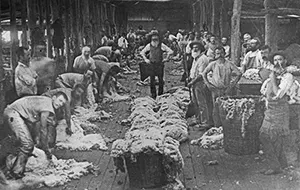
Photo: Men at work in wool shearing shed
Macpherson and three policemen had given chase to one of them, a man named Samuel Hoffmeister, who was said to be responsible for starting the fire. They didn't catch Hoffmeister, but he was found dead a day later at the Four Mile Billabong near Kynun with a gunshot wound, which appeared to be a case of suicide. In a radio interview in 1936, Banjo Paterson said, "The shearers staged a strike by way of expressing themselves, and Macpherson's woolshed was burnt down, and a man was picked up dead". There was also a story doing the rounds at that time about a police posse on the lookout for Harry Wood, a man accused of beating an Aboriginal boy to death. They didn't find Harry. But they did come across a hapless swagman camped by a billabong (possibly the Como billabong) who took fright at the sight of the approaching police and jumped into the billabong and drowned.
Listen to Waltzing Matilda on a Zither
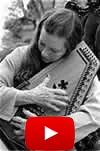
While at the station, Banjo frequently heard Bob's sister, Christina Macpherson, play a tune on her zither (sometimes called an autoharp). Banjo liked the " whimsicality and dreaminess" of the melody and thought it would be nice to set some words to it.
Banjo, a lawyer by trade and a journalist by profession, was also an accomplished poet. So, naturally, he would have stored away a wealth of knowledge, stories, and other tidbits about life in the outback and the people who lived there. When the opportunity came, he quickly pieced together a "case" - a story to produce a light-hearted ditty as part of an evening's entertainment. So it appears that Banjo linked up all these events to create the song's storyline and the lyrics. Christina played the tune on her zither and wrote the musical score.
In the same radio interview in 1936, Banjo goes on to say, "Miss Macpherson used to play a little Scottish tune on a zither, and I put words to it and called it 'Waltzing Matilda'."
On a visit to Winton town, Banjo and Christina polished the song up using a piano in the parlour of the North Gregory Hotel in Winton. Soon after, Herbert Ramsay was the first person to sing Waltzing Matilda to an audience. Herbert, who was one of the best tenors in the area, sang the song either at Sarah's brother's house or the Post Office Hotel in Winton.
What Waltzing Matilda Originally Sounded Like
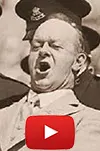
The song spread rapidly throughout the district by word of mouth and was an instant hit. The Governor of Queensland, Lord Charles Lamington, visited Winton On 25 September 1900, and Herbert Ramsey sang the song at a banquet held in the governor's honour at the North Gregory Hotel.
How Waltzing Matilda Became Australia's Favourite Song Evolution into Today's Iconic Song
The story of Waltzing Matilda didn't end with Banjo Paterson and Christina Macpherson writing the song and gaining popularity as a bush ballad in the Australian outback. In 1900, Paterson sold the lyrics to what he considered just a minor little ditty, bundled together with several other works, to Angus and Robertson publishers for the princely sum of "five quid" (about A$670). We can only guess that he probably valued the song for about $20.
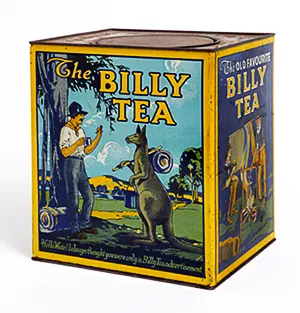
Photo: Tin of Billy Tea
According to records held by the State Library of New South Wales, James Inglis & Co bought a bundle of lyrics from Angus & Robertson in 1902. In this bundle were the lyrics for Waltzing Matilda. James Inglis & Co was an importer of tea and sold over 680,000 kilos (1.5 million lbs) of tea annually under the "Billy Tea" trademark. They were in search of a catchy tune to promote their tea. Waltzing Matilda, they thought, with some improvement, would be just perfect.
In 1903, Marie Cowan, the wife of the chief accountant working at James Inglis & Co and a gifted musician, was entrusted with improving the original lyrics. Fortunately, Marie had heard the original musical tune composed by Christina McPherson. So, she recomposed the song by changing some of the lyrics to fit the melody better. The sheet music and lyrics were then printed and wrapped around containers of Billy Tea as a promotional gimmick. It wasn't long before the song gained widespread popularity. This version of the song, known as the Marie Cowan version, is the one we hear today.
Waltzing Matilda travelled with Australian troopers to the Boer War and the First World War. It was sung boisterously by Australian soldiers and picked up by troops of other nationalities such as the British and Americans. Before long, it was known throughout the world even though, in most instances, those singing it had no idea where the song originated. For over a century now, it has been a favourite with Australian troops whenever they travel overseas.
Waltzing Matilda is one of those rare songs that hasn't aged. It has been with us for over a century and is still popular today. It is frequently used in major public events. Some say that more Australians know the words to this song than possibly even their national anthem.
Who Sang Waltzing Matilda First?Oldest Surviving Recording of Waltzing Matilda
First Recording of Waltzing Matilda
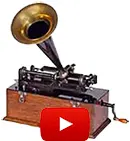
The first known recording of the song was made in 1926 in London, England by a singer named John Collinson. The recording is barely two minutes long. It almost seems like the singer was rushing through the song to make sure it all fitted in the old-fashioned wax recording disc, which only had a recording capacity of about two and a half minutes. While it can be recognized as Waltzing Matilda, it is interesting to note that this version is different from the one we are familiar with today. There is a subtle but noticeable difference in the melody.
How Many Versions of Waltzing Matilda? Over 700+ Versions of the Song
There are over 700+ different recorded versions of Waltzing Matilda by local and international artists in various genres ranging from classical, country, rock and rock, jazz, and even yodelling. As a result, there are no definitive lyrics or music to the song Waltzing Matilda. The version most often heard today is the Marie Cowan version, which has a cheerful sing-a-long tone to it.
The Queensland/Banjo Patterson version is thought to be the original written by Banjo Paterson and has a definite bush ballad ring to it. Another version, known as the Harry Nathen version, is now lost.
Other Poems by Banjo Paterson Australia’s Foremost Bush Poet
The Man from Snowy River — describes the story of the recapture of a valuable colt that was living with wild horses.
Clancy of The Overflow — is the story of a city dweller's yearning for the carefree life of an Outback Australian drover.
Mulga Bill's Bicycle — Mulga Bill buys himself a bicycle and boasts he can ride this machine with ease. He is in for the ride of his life.
A Note About This Web Page
This page was originally written in 1997 by Trishan, an eleven-year-old Australian boy and his dad. Over the years, this page continued to rate in the top 10 sites in Google's ranking on the subject. We have now given the page a long overdue face-lift with new video clips (which didn't exist at the time the page was originally written) and lots of additional content. We have, however, decided to maintain some of the "look and feel" of the original website. So you will still see Trishan's artwork as it appeared on the original website.
